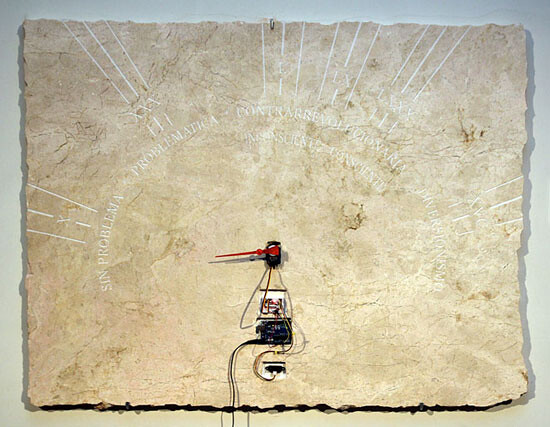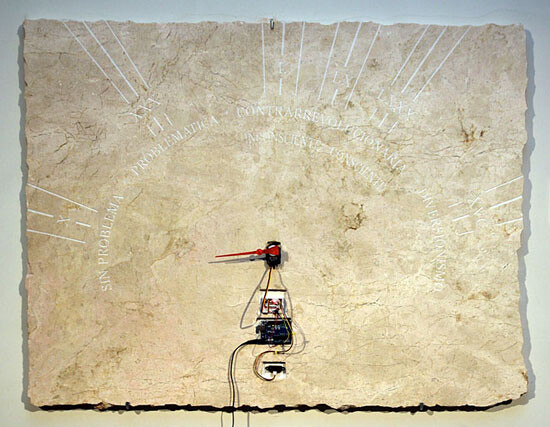“Art is a santería altar that sometimes needs to be fed violations of civil rights.”
—Tata Watashi
Tania has taken advantage of a specific situation to define a problem by means of an attempt at an “aRtivist” action. She knows perfectly well that there are only two answers to her project: “yes” or “no.” Either answer will provide good results that will beef up her artistic CV more than advancing civil rights in Cuba. She knows the game, and she sets it in motion; others have no choice but to become part of the game. From the start she had nothing to lose professionally. Everything was in her favor, whether she was able to realize her performance (aRtivist action) or not. Censorship makes it such that Tatlin’s Murmur becomes Tania’s Noise with all the actors playing their parts according to an existing script: the formation of a new platform, social networks, media coverage, support, alerts, dialogues, negotiations, repressions, detentions, solidarity, liberation, and so on. In spite of all of this, whether the authorities allowed the action or censored it, there would be a performance. Tania and her followers would assume the task of explaining and theorizing everything after the fact. In that sense, #YoTambienExijo (#IALSODemand) was a well-devised (or well-intuited) strategy. Its “creative act” consists of searching for, finding, taking advantage of, and stating a problem with two possible “preprogrammed” answers (the old formula of action-reaction), either of which, through a media push, would score points for her career. In Cuba, if any common citizen residing in its territory gets involved in dissident actions or open opposition actions against the government, the negative repercussions in their daily lives are immediate, especially if they are unprotected. For a Cuban artist (and a protected person of note) who spends most of her time outside Cuba and uses the struggle for civil rights as a medium for aRtivism within Cuban territory, a confrontation with the government will have no negative repercussion in a daily life lived outside the government’s reach. On the contrary, coming to Cuba is a means of scoring “points” for the “international circuit” of “global” art through a direct confrontation with an authoritarian government. Cuba continues to be a place where interesting things happen. A few months ago, for example, the visible state of the Independent Republic of Havana held a show by Pedro Pablo Oliva that the invisible state of the Independent Republic of Pinar del Río refused to show.1
Can someone conceive of a performance in the name of civil rights, knowing beforehand that it will be forbidden, and take advantage of the censorship? The answer is yes, and Tania just showed that it is possible. She read Foucault a long time ago, and knows that he who controls space controls human behavior. This is applicable to all sorts of spaces, whether it is that of a “public” institution within the artistic system or a public space outside the artistic system. I do not know if the state has read Foucault, but the author’s ideas are applicable in our context. In Cuba, the state controls public space; spontaneous gatherings are not welcome. Institutional violence, mostly in the provinces, against any street demonstration considered to be dissident or oppositional attests to that. Only in 1994, during the “Maleconazo” uprising, did the state lose control, briefly, over a part of the capital’s public space. One example among many: since the 1990s, Óscar Elías Biscet, in the name of human rights, has tried to operate in the capital’s public space and in that of the provinces, to work on the conscience of the common citizen through civil disobedience. The government’s reaction against him has been harsh. The street belongs to the state, whether it is called Fidel or Raúl. Let us remember the slogan: “This street is Fidel’s!” Tania knew perfectly well that she would not be allowed to realize her piece. Or perhaps she is naive, or suffering from amnesia after having spent so much time outside Cuba that she forgot how things operate inside the country. Does she not remember how they “prevented” her from continuing her independent publication Memorias de la posguerra (Post-War Memories) in the early 1990s? Did she forget what happened during the 10th Havana Biennial in 2009 with Tatlin’s Murmur #6? Did she think that things had changed magically and instantly on December 17, 2014? Did she believe that they would tell her: “Welcome, the square belongs to the people. Let’s open all microphones and let all voices be heard. The police are here to ensure that citizens can freely express their thoughts”? I do not believe that.


I agree 100 percent with the ideas in Tania’s letter of December 18, 2014 from Vatican City, for reasons that go beyond and precede her letter. In this country, there are many people fighting for civil rights. I think that they would have loved Tania if, when they were being harassed, she had been nearby, making useful art. For them, the struggle for civil rights started long ago, and not on December 30, 2014 at 3:00 pm in Revolution Square. The second-to-last paragraph in Tania’s letter reads: “Today, I would like to propose to the Cuban people, wherever they are, to come out on the streets on December 30 to celebrate, not the end of the blockade/embargo, but the beginning of their civil rights.” In any case: welcome!
As happened after Tatlin’s Murmur #6 in 2009, Tania will leave Cuba with another achievement on her CV. On social networks both digital and real, she will be criticized and also praised for her audacity and courage. Some critics and curators will feature her in contemporary art texts, exhibitions, and so forth. There will also be Cubans left in this country fighting for civil rights, and as always, there will be thousands of people outside Cuba pushing them to do so. But he who pushes doesn’t get beaten. Let’s not confuse the act of pushing with real support from the outside. Many people have been left thinking that #YoTambienExijo was an infantile action in the style of “Hey, you guys, let’s go make some noise! And if they arrest us, all the better. Every mistreatment against one’s person is a badge of honor!”
#YoTambienExijo was more a provocation than a real advance for civil rights. It told us that the government does not open the microphone so that all voices can be heard, but we’ve been told this many times already. We’re tired of hearing it. Everyone knows it, including the government. A more interesting (and, of course, more difficult) project would have been to find an intelligent way, evading censorship and the formal structures of social control, to create a temporary autonomous zone (TAZ) where it would have been possible to “open the microphones” to hear “all voices.” But she failed in her attempt. The voices still wait to be heard. I think that any citizen of this country, including all dissidents and opposition groups, have the right to be heard publicly by all, just as the state does. The challenge of achieving this remains. Other long-standing problems also remain: Are civil rights one of the many media for creating art, or is art a medium to fight for civil rights? Is art or aRtivism a genuinely effective medium to fight for civil rights? What is the ideal of the nation we are building? Tania ends her letter from Vatican City by saying: “Let us make sure that it will be the people who will benefit from this historic moment. The homeland is what causes us pain.” But we all know that what really hurts any artist is not being able to live off his or her art, and some artists’ threshold for pain regarding the homeland comes very occasionally and capriciously. What really hurts them is having their toes stepped on.
In September 2014, Cuban painter Pedro Pablo Oliva’s solo exhibition titled ‟Utopias and Dissidences” in Pinar del Rio was censored. See →.
Category
Subject
Translated by Ernesto A. Suarez
